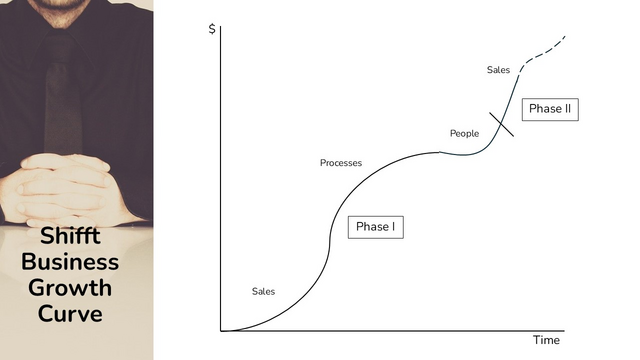Growth is often seen as the ultimate marker of success in business. More sales, more clients, more employees—all signs that your business is thriving, right? However, bigger doesn’t necessarily mean better. While revenue might climb, profit margins don’t always follow suit. In fact, as businesses grow, complexity increases, requiring higher levels of management skill and more sophisticated systems. In this article, we’ll explore the challenges of growth, the life cycle of businesses, and how to navigate the inevitable plateaus with a focus on sustainable success.
The Business Growth Life Cycle
Business growth follows a predictable pattern that can be visualised as an S-curve. Each phase of the curve comes with its own opportunities and challenges:
1. Startup Phase: At the beginning, businesses focus on generating sales and turning those sales into early profits. This is a high-energy, entrepreneurial phase where processes and systems are often minimal.
2. Process and System Building: As the business grows, the need for structured processes and systems becomes clear. These provide the foundation for scalability but often lead to a plateau as the business consolidates and adjusts to the new complexity.
3. Team Expansion: With solid systems in place, businesses can hire additional team members to take advantage of the efficiencies created. However, scaling up often exposes weaknesses in systems and processes, leading to new challenges.
4. Rapid Growth Phase: Once the business has optimised systems, processes, and team capacity, it can ramp up sales again, entering a phase of accelerated growth.
This cycle repeats itself as the business grows, creating a rhythm of consolidation and expansion. Recognising where you are in the cycle is crucial to understanding the specific actions needed to move forward.

The Challenges of Growth
While growth is desirable, it comes with inherent challenges that can derail even the most ambitious businesses. Here are some of the key hurdles:
1. Sales Outpacing Capacity
Businesses that excel at sales often find themselves growing faster than they can deliver. This leads to overstretched resources and the need to hire quickly. Unfortunately, without robust systems and processes, new hires may struggle to perform efficiently, leading to declining profit margins.
2. The Plateau Effect
Investing in processes and systems is essential, but it doesn’t always deliver immediate results. In some cases, it can make the business more complex and slow operations temporarily. Processes designed to meet quality or safety standards can add necessary layers of complexity but may also stifle agility and innovation.
3. People and Productivity
Even with strong systems, businesses can struggle to see a return on their investment if employees aren’t operating in a focused and productive manner. Without clear priorities and accountability, teams may go through the motions without driving meaningful results.
Breaking Through Plateaus with Focused Execution
One of the keys to overcoming growth challenges is cultivating a culture of focused execution. Borrowing from methodologies like Scrum, focused execution emphasises prioritisation and accountability, ensuring that every team member is aligned on what needs to be achieved.
Key Components of Focused Execution:
- Must, Should, Could Prioritisation: Identify tasks and projects in terms of what absolutely must be done, what should be done if resources allow, and what could be tackled if there’s additional capacity.
- Weekly and Daily Focus: Break down larger goals into manageable, actionable tasks. Teams should know exactly what is expected of them each week and have a clear understanding of how their work contributes to larger business objectives.
- Accountability and Management: Productivity improvements don’t happen overnight. Leaders must actively manage the team, holding them accountable for outcomes while providing support and guidance.
- Cultural Alignment: New hires should embrace the culture of focused execution or be coached to align with it. This ensures that everyone is moving in the same direction, maximising productivity across the board.
The Impact of Focused Execution:
When implemented effectively, focused execution can lead to productivity increases of 30% to 300%. It aligns teams around clear goals, improves utilisation of new systems, and creates a foundation for sustainable growth.
The Interplay Between Systems, Processes, and People
While systems and processes are critical to scaling a business, they are not enough on their own. Without engaged, focused people to execute them effectively, even the best systems can fail to deliver results.
To achieve true leverage, businesses must integrate systems and processes with a culture of focused execution. This combination enables teams to work smarter, not harder, and ensures that the business is ready to ramp up sales without sacrificing profitability.
Practical Steps for Sustainable Growth
1. Evaluate Your Current Phase: Identify where your business is in the growth cycle. Are you building systems, hiring a team, or consolidating after a period of rapid growth? Tailor your strategy to match your current phase.
2. Focus on Execution: Build a culture of prioritisation and accountability. Ensure that every team member understands their role in driving the business forward.
3. Simplify Complexity: Streamline systems and processes where possible. Avoid over-engineering solutions that could slow your team down unnecessarily.
4. Invest in Training and Management: Equip your team with the skills and tools they need to operate effectively within the new systems. Provide regular feedback and hold them accountable for results.
5. Prepare for the Next Growth Phase: Once your systems, processes, and team are optimised, switch on your sales engine to capitalise on the new capacity.
Conclusion
Growth is not a straightforward journey. It requires careful planning, a willingness to adapt, and a deep understanding of the business growth cycle. By recognising the challenges of growth and focusing on systems, processes, and people, businesses can achieve sustainable success without falling into the trap of “bigger is better.”
With the right strategies in place, your business can navigate plateaus, break through barriers, and continue climbing the growth curve—profitably.



